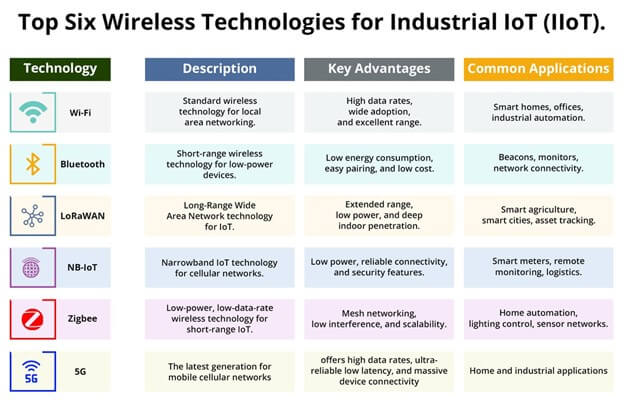Antennas, Antenna Cables, Wireless Products: Technical Articles
IIoT Top Six Wireless Technologies Compared: Industrial Internet of Things

Top 6 Wireless Technologies for IoT & IIoT
The rapid proliferation of the Industrial Internet of Things (IIoT) in various industries has opened up new avenues for enhanced operations, real-time data analysis, and increased productivity. At the heart of this digital transformation lies wireless connectivity – the enabler of instantaneous communication between devices. In this article, we'll delve into the most prominent wireless connectivity solutions utilized in IIoT and how they stack up against each other.
1. Wi-Fi (Wi-Fi Antennas)
Advantages:
- Ubiquity: Already a widespread standard in many commercial and residential environments.
- Data Rate: Can support high data rates, suitable for streaming video and other large data applications.
Disadvantages:
- Range: Limited to around 100m in typical conditions. Although range extenders can mitigate this, they add complexity.
- Power Consumption: Generally higher than some other wireless technologies, which may not be ideal for battery-operated IIoT devices.
2. Zigbee (Zigbee Antennas)
Advantages:
- Low Power: Designed for devices that need long battery life.
- Mesh Networking: Devices can communicate through other devices, extending the effective range and redundancy.
Disadvantages:
- Data Rate: Lower data rates than Wi-Fi, not suited for applications requiring high bandwidth.
- Interference: Operates in the crowded 2.4 GHz frequency band, which may lead to interference.
3. LoRa (LoRa Antennas)
Advantages:
- Long Range: Can achieve ranges of up to 15 km in rural areas and 5 km in urban settings.
- Low Power: Offers prolonged battery life, ideal for remote IIoT sensors.
Disadvantages:
- Data Rate: Limited data rate means it's not suitable for high-bandwidth applications.
- License: Depending on the country, there may be licensing requirements.
4. Cellular (4G Antennas, 5G)
Advantages:
- Range: Leveraging the existing cellular infrastructure ensures broad coverage, especially beneficial for IIoT devices in remote areas.
- High Data Rates: Especially with 5G, extremely high data rates are achievable.
Disadvantages:
- Power: Typically higher power consumption than Zigbee or LoRaWan gears.
- Cost: Recurring costs associated with data plans and possible hardware premium.
5. NB-IoT (NarrowBand IoT)
Advantages:
- Deep Penetration: Enhanced range allows for connectivity in challenging environments, like underground.
- Low Power: Designed for applications where long battery life is essential.
Disadvantages:
- Data Rate: Not suited for high-bandwidth applications due to limited data rates.
- Coverage: While growing, NB-IoT coverage is not as extensive as traditional cellular networks yet.
6. Bluetooth and BLE (Bluetooth Antennas)
Advantages:
- Power: BLE is designed for low-power applications and can last years on a coin-cell battery.
- Ubiquity: Many devices already support Bluetooth,facilitating integration.
Disadvantages:
- Range: Typically limited to around 100m, although newer versions are pushing this boundary.
- Data Rate: While higher than some, not on par with Wi-Fi or cellular.
Other IIoT Wireless Connectivity Solutions
1. LPWAN (Low-Power Wide-Area Network)
LPWAN technologies like LoRaWAN and Sigfox are designed to connect devices over long distances while consuming minimal power. These networks are ideal for applications such as IoT asset tracking, environmental monitoring, and smart agriculture.
2. Edge Computing
Edge computing involves processing data closer to the source, reducing latency and bandwidth usage. IIoT devices can now perform data analytics and decision-making at the edge, enhancing efficiency and reducing the need for constant data transmission to the cloud.
3. Mesh Networks
Mesh networks use interconnected devices to relay data, creating a self-healing and resilient network. This approach is valuable in industrial environments where signal interference or device failure can disrupt communication. Mesh networks ensure robust connectivity even in challenging conditions.
4. Private 5G Networks
Some industries require dedicated wireless networks to meet their specific needs. Private 5G networks provide the advantages of 5G technology within a controlled and secure environment, making them suitable for applications like manufacturing automation and smart warehouses.
Benefits of IIoT Wireless Connectivity
1. Increased Efficiency: IIoT wireless connectivity solutions enable real-time monitoring and control of au industrial processes, leading to improved operational efficiency and reduced downtime.
2. Cost Savings: The elimination of extensive wiring and the ability to remotely monitor and maintain equipment result in significant cost savings over time.
3. Predictive Maintenance: IIoT enables predictive maintenance by collecting data from sensors and analyzing it to detect equipment issues before they lead to costly breakdowns.
4. Enhanced Safety: IIoT systems can monitor and respond to safety breaches, reducing the risk of accidents and ensuring a safer working environment.
5. Data-Driven Decision-Making: The wealth of data generated by IIoT devices empowers organizations to make data-driven decisions, optimize processes, and identify new revenue streams.
Conclusions
The Industrial Internet of Things (IoT) has revolutionized the way industries operate, providing unprecedented opportunities for efficiency, productivity, and cost savings. IIoT leverages the power of connected devices and data analytics to optimize processes, reduce downtime, and improve decision-making. At the heart of this transformation lies wireless connectivity solutions, which enable seamless communication between devices and systems in industrial settings.
IIoT wireless connectivity solutions are at the forefront of industrial transformation, driving efficiency, productivity, and innovation. Advancements in 5G, LPWAN, edge computing, mesh networks, and private 5G networks are expanding the possibilities for IIoT applications across various industries. As organizations embrace these technologies and overcome the associated challenges, they are poised to reap the rewards of a more connected and efficient industrial landscape. The future of IIoT looks promising, with wireless connectivity playing a central role in shaping its evolution.
While IIoT wireless connectivity solutions offer immense benefits, they also come with challenges, such as security concerns, interoperability issues, and the need for skilled personnel to manage and maintain these networks. Therefore, organizations must carefully plan and implement their IIoT strategies.
In the past, industrial environments relied heavily on wired connections for communication between machines and control systems. While wired connections offered reliability, they came with limitations such as inflexibility, high installation costs, and maintenance challenges. The advent of wireless connectivity in IIoT has addressed these issues and unlocked new possibilities for industrial applications.







